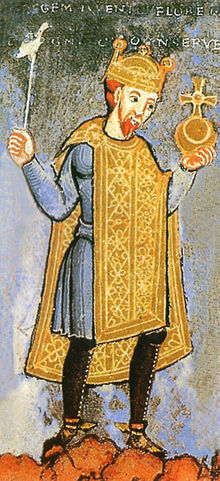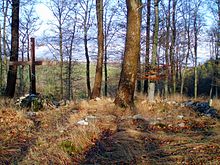Bodfeld
Bodfeld was a royal court that was primarily set up for hunting purposes and was used for the administration of the power-supporting ore extraction of the Ottonian and Salian kings and emperors in the middle Harz near the later town of Elbingerode .
The term also describes a forest area mainly south of Elbingerode .
history
On the basis of the documents handed down, at least 17 stays of kings or emperors in Bodfeld can be proven, who stayed here during hunts. Heinrich I stayed in Bodfeld several times, so he fell ill here in 935, as the vita Mathildis describes in 968. Otto I. characterized Bodfeld in a document (Quedlinburg) dated September 13, 936 as a hunting farm; he was at least three times, Otto II four times in Bodfeld. Otto III. In 991 visited Bodfeld together with his grandmother Adelheid for at least 14 days and again in 995. Konrad II was demonstrably once, Heinrich III. here at least four times. The last document he issued was drawn up in Bodfeld (September 28, 1056). Henry III. died after seven days of illness on October 5, 1056 in Bodfeld in the presence of the Pope and many imperial princes. Heinrich IV was raised to the rank of German king in Bodfeld in 1056.
Beginning at the end of the 13th century, the royal Jagdhof Bodfeld and its exact location have been forgotten. Only through the intensive research of Paul Höfer was the memory of Bodfeld revived at the end of the 19th century. In view of the place name Königshof (1936 after merging with Rothehütte until today Königshütte ), he imagined the Königsburg on a rocky hill above the confluence of the Warmer and Kalter Bode rivers . He published about it several times in the journal of the Harz Association for History and Archeology . Carl Schuchhardt , among others, agreed with his opinion in his 1924 publication The Early History Fortifications in Lower Saxony . In 1933, the castle researcher Paul Grimm proved, based on the fact that no red ceramics were found during the excavations on the royal castle, that the royal castle was by no means built in the time of the Saxon kings, but later. Schuchhardt had already changed his mind in the run-up to this in 1931.
Grimm now suspected Bodfeld to be on the other, northern side of the Bode am Papenberg near or at the site of the Lüttgen-Bodfeld desert , whose St. Andrew's Church was designed by Dr. Müller had been exposed. However, he left a final statement open and wrote: "Determining the exact location of the Jagdhof Bodfeld is left to later research." (HZV, 66, p. 32)
The diplomat Carl Erdmann also doubted Höfer's thesis in 1940 and agreed with Grimm's opinion. Other researchers, such as Friedrich Stolberg , author of the standard work Fortifications in and on the Harz Mountains from Early History to Modern Times , first published in 1967 , followed suit and wrote: The Königsburg near Königshütte "is not directly related to the royal Jagdhof Bodfeld on the other side of the Bode." (P. 211)
Only the most modern infrared aerial photography technology and the latest archaeological analyzes of found stone objects confirmed the previously known existence of a palace complex from the Ottonian period at the Schloßkopf on the upper reaches of the Teufelsbach in the Dreck Valley northeast of Elbingerode. This could be the Bodfeld Königshof, which, typical for the time of its creation, was built on a mountain spur (see also Königspfalz Werla ), although the eponymous river Bode is about four to five kilometers away from here, but this is irrelevant appears because the medieval Bodfeld comprised extensive terrain.
The plant to the buckle head corresponds to the I of Heinrich-scale Palatinate Grona from the Baucharakteristik. Carl Erdmann had already referred to the king buried in Quedlinburg as the builder of Bodfeld on the basis of written records and proved that Bodfeld cannot be ascribed the political character of a "Palatinate" . This also underpins the fact that the monarchs staying in Bodfeld demonstrably did not celebrate an important church festival here, but always did so in other places such as Quedlinburg, Magdeburg or Goslar . Friedrich Stolberg, on the other hand, had already pointed out in 1967 that this complex is related to the Saxon hunting grounds such as Siptenfelde and the proximity to the Königsstieg suggests a connection. It is very likely that there was also a connection between this hunting lodge, mentioned in 1483 and 1531, with the village of Erdfelde on the old Halberstädter Heerstraße, mentioned in a document from the Counts of Regenstein in 1343 , which was only 1.5 kilometers away and was abandoned in the late Middle Ages in favor of the neighboring Elbingerode .
Of Heinz A. Behrens , historian and Bauarchäologe, the new research results are due to, is a reconstructed view before the entire system on the basis of archaeological and geoelectric measurements.
Bodfeld forest area
The forest area that Heinrich II. Left to the Gandersheim monastery in 1009 as part of an exchange is also known as Bodfeld . Its limits can be found in a loan from Abbess Sophia von Gandersheim from 1319. Accordingly, this forest area extends from Braunlage in the west to Elbingerode in the northeast and Stiege and Benneckenstein in the south.
Further hunting grounds in the Harz Mountains
- Siptenfelde , here Otto I. made two documents
- Hasselfelde , Heinrich III stayed here. at least twice
literature
- Götz Alper: Royal landscape and iron extraction in and on the Middle Harz. The Pfalzen Bodfeldt and Derenburg. In: Stephan Freund , Rainer Kuhn (Hrsg.): Medieval royal palaces in the area of today's Saxony-Anhalt. History, topography, state of research (= Palatium. Studies on Palatinate Research in Saxony-Anhalt. Vol. 1). Schnell & Steiner, Regensburg 2014, ISBN 978-3-7954-2968-3 , pp. 77-114.
- Heinz A. Behrens : German royal palaces in the Harz. From Werla to Quedlinburg. NAG - Nordharzer Altertumsgesellschaft eV, Thale 2016.
- Martin Prell: On old ways to new knowledge. A contribution to research into the medieval settlement of the Elbingerode plateau in the Harz. In: North Harz Yearbook. 4, 1971, ISSN 1438-5341 , pp. 7-27.
- Lutz Wille: To the location of the Reichshof Bodfeld. In: Harz-Zeitschrift. Vol. 62, 2010, ISSN 0073-0882 , pp. 153-167.
Individual evidence
- ^ Karl Schnith : Emperor Heinrich IV. In: Gerhard Hartmann, Karl Schnith (ed.): The emperors. 1200 years of European history. Marix, Wiesbaden 2006, ISBN 3-86539-074-9 , pp. 203–228, here p. 208.
- ^ Carl Schuchhardt : The castle in the course of world history. Akademische Verlagsgesellschaft Athenaion, Potsdam 1931, p. 227.
- ^ Carl Erdmann : Contributions to the history of Heinrich I. Part 1: The royal court Bodfeld. In: Saxony and Anhalt. Vol. 16, 1940, ISSN 0945-2842 , pp. 77-90, here p. 82 .
- ↑ Jürgen Korsch, Albrecht von Kortzfleisch : The historic Bodfeld - the new "Upper Harz am Brocken" or a Harzer quarreling peak? In: The Harz. Magazine for people from the Harz Mountains and friends of the Harz Mountains. Edition 12/2009.
Coordinates: 51 ° 47 ′ 20 ″ N , 10 ° 50 ′ 19 ″ E

